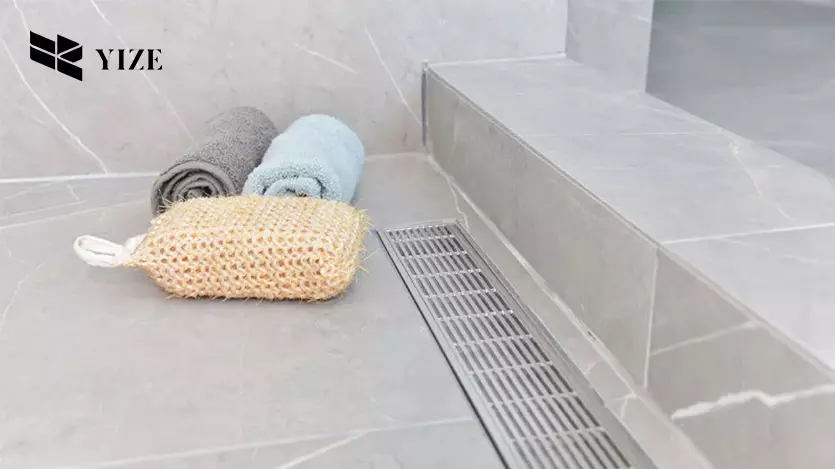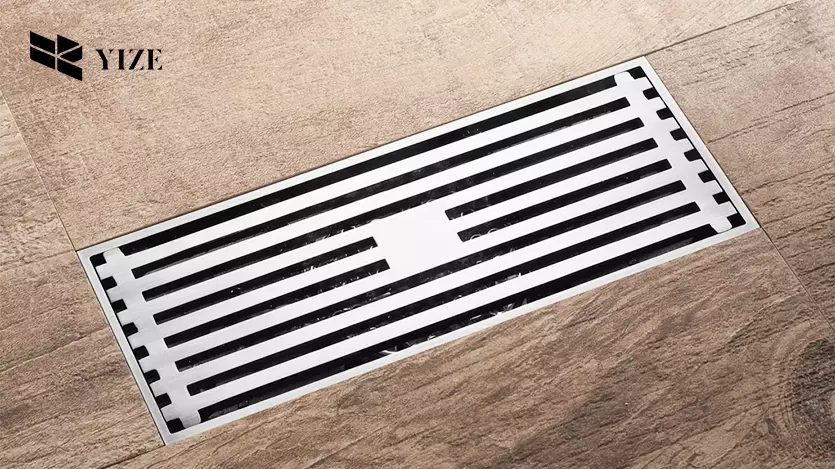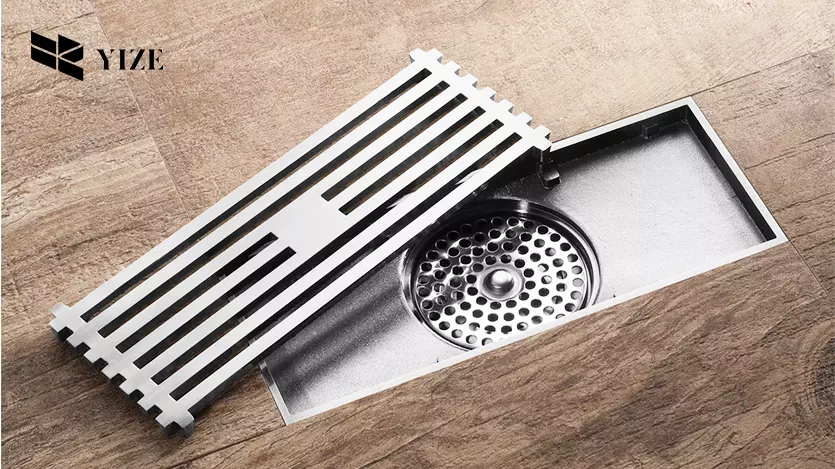
I. Introduction
Modern bathrooms would benefit much from brushed nickel linear shower drains. These drains improve both utility and style since they are known for their modern appearance and great resilience. They are meant to easily fit bathroom designs and effectively manage big volumes of water.
Still, keeping brushed nickel linear shower drains beautiful and efficient calls for regular cleaning. As soap scum, hair, and other trash builds over time, clogs and discoloration can result. This book will walk you through easy but powerful actions to maintain perfect drain condition, so guaranteeing long-term performance and a shining appearance.
II. Understanding Brushed Nickel Linear Shower Drains
1. What Is a Brushed Nickel Linear Shower Drain?
Linear shower drains brushed nickel are shower drains that have a sleek, thin line design installed at the base of the shower. Linear shower drains are different from circular-shaped drains, which are more conventional in terms of the shape. Contemporary and sleek, the brushed nickel finish is one that allows objects to have a matte non-shine effect that is not prone to fingerprint or water stains- ideal for the modern bathroom.
These drains are usually constructed from stainless steel or other resistant material and then covered with nickel finish for appeal and protection against corrosion. Basically there is a lot of difference between the polished kind and the brushed type: the latter is matte and this makes it more resistant to rust as well as dullness.
2. Are Linear Shower Drains Better?
There are number of benefits associated with linear shower drains as compared to the round shower drain. Here are some key benefits:
- Improved Functionality: Linear drains are designed to withstand large volumes of water; therefore they are suitable for walk in showers.
- Aesthetic Appeal: They are elegant, and fit perfectly well in the contemporary bathroom.
- Ease of Accessibility: This makes linear drains suitable for the design of barrier-free showers and therefore appropriate for use in universal design.
Linear shower drains function in a conventional way, whereby water is directed to a long, slim aperture located along the perimeter of the shower area floor. This helps in creating passage way for water as well as hindering formation of trapped water.
For contemporary baths, linear shower drains may be great. Such appearances plus practical characteristics explain why homeowners and designers tend to opt for their line.
III. Common Issues and Maintenance Needs
1. Common Linear Shower Drain Problems
Even these brushed nickel linear shower drains have their limitations. Some common problems include:
- Clogging: Build up of hair, soap scum and other materials can cause this channel to be blocked.
- Discoloration: Scrubs, inadequate rining and use of chemical solution can cause the brushed nickel finish to fade.
On the same note, even with these challenges, linear shower drains do not have to be costly to maintain as compared to the traditional shower drains. Most issues can be avoided if the products are cleaned and well maintained as instructed.
2. Tips for Selecting the Right Linear Shower Drain
Selection of drain entails the right functionality and aesthetic appearance in the compound. Here are some tips:
- Size: Make sure that the drain size matches the size of your shower. A 24 inches linear shower drain of brushed nickel are usual when installing medium shower plans.
- Quality: It is also advisable to use high quality products of good brands such as YZDRAIN. They provide long-lasting trendy products that do not get faded and are quite easy to clean as well.
IV. Easy Cleaning Steps for Brushed Nickel Linear Shower Drains

1. Step 1: Gather Your Cleaning Supplies
Get the following before you wash your brushed nickel drain:
- Mild detergent or dish soap
- Soft cloth or sponge
- Rainwater (if limescale is used opt for white vinegar)
- Small brush or old toothbrush
- Warm water
Brushed nickel finish should not be cleaned using abrasive cleaners or scrubbing pads since they will harm it.
2. Step 2: Remove and Clean the Drain Cover
The first process is to very slowly open the drain cover. majority of the linear shower drain systems have a top writing that can be lifted off to give way to access to the drain.
- How to Remove: Be extremely careful, either use a flat tool, or try to pick the cover with your hand with fingers.
- Cleaning the Cover: Rinse the cover with warm soapy water, to eliminate soap scum as well as any other dirt. For hard-to-remove stains, a good dose of vinegar should be used for about 5 minutes before the use of a soft bristle brush.
3. Step 3: Drain Body and Outlet.
Once the cover is removed, clean the interior of the drain body:
- Interior Cleaning: Rinse it gently with water and using a small brush or toothbrush clean the outside part of the drain body. Do not rub the surface or apply pressure in order not to mar the finsh.
- Outlet Clearing: There should also be blockage in the drain outlet. In the case that hair or debris has clogged the drain, a drain snake or tool should handle this.
4. Step 4: Rinse and Dry the Components
After washing, make sure you rinse all parts with warm water. Make absolutely certain that there is no trace of cleaning contractors or cleaners, or cleaning products on any surface or object in the building.
- Drying: After that, wipe the drain cover and the body part of the drain cover with a soft cloth. Drying eliminates chances of water spot forming on brushed nickel surface and also reduces chances of mineral deposit forming.
5. Step 5: Reassemble and Ensure Proper Discharge
Replace the drain cover properly and pour some water to check out if the drain is working fine or not. If the water does not flow with ease then rinse and wash it again to remove any obstructions that may be remaining.
V. Ongoing Maintenance to Prevent Issues
1. Regular Cleaning Schedule
- Plan frequent cleaning to maintain the best possible state of your linear shower drain. Regular cleaning—weekly or bi-weekly—helps to avoid clogs by preventing accumulation.
- After every use, wipe down the drain cover to get soap and water residue off.
- Every one to two months do a thorough clean.
2. Utilizing Drain Screens
- One great tool for avoiding clogs is a drain screen. Before they find their way down the drain, it catches trash and hair.
- Select a premium screen that will match your drain capacity.
- Empty the screen often to keep it effective.
VI. Why Choose YZDRAIN’s Brushed Nickel Linear Shower Drains?

Benefits of YZDRAIN’s Products
Among the best brushed nickel linear shower drains available now is YZDRAIN. Here’s why you ought to give their offerings some thought:
- Their drains have a premium brushed nickel finish that st resists discolouration and staining.
- Built with cleaning in mind, YZDRAIN’s products are simple to disassemble and clean.
- Competitive pricing makes them affordable without sacrificing quality.
- YZDRAIN is well-known for provide consistent and fashionable ideas.
VII. Conclusion
Any bathroom would be enhanced both aesthetically and functionally by brushed nickel linear shower drains. Following these simple cleaning techniques guarantees long-lasting performance and helps you to keep their elegant look. Regular maintenance and good care help to avoid typical problems, so maintaining the fashionable and effective shower drain.
The brushed nickel linear shower drains of YZDRAIN are quite good for premium choices. Modern bathrooms would especially benefit from their durability, simplicity of maintenance, and pleasing look.
Frequently Asked Questions (FAQs)
Q1: How often should I clean my brushed nickel linear shower drain?
For a brushed nickel linear shower drain, it’s recommended to clean it once or twice a month by wiping it down with a soft cloth, depending on how frequently you use the shower; if you notice a buildup of hair or debris, clean it more often.
Q2: Can brushed nickel benefit from abrasive cleaners?
No, abrasive cleaners might compromise the finish. Instead use soft tools and a light detergent.
Q3: Does maintaining a linear shower drain cost more?
Not inevitably. Good maintenance and regular cleaning help to reduce expenses.
Q4: With what linear drain size should I go?
The ideal linear drain size depends on the size of your shower area, Popular for medium-sized showers is a 24-inch drain. with most residential showers using a 2-inch drain that should be roughly 10cm shorter than the width of your shower enclosure; for example, if your shower is 100cm wide, a 90cm linear drain would be suitable.
Q5: Why should I use a drain screen?
Drain screens help to avoid blockages by preventing trash from clogging the drain, so simplifying cleaning.

